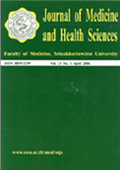ความหลากหลายทางพันธุกรรมของพยาธิเท้าช้างในแมวรังโรค
Keywords:
พยาธิเท้าช้าง, ความหลากหลายทางพันธุกรรม, สัตว์รังโรคAbstract
โรคเท้าช้าง เป็นปัญหาทางสาธารณสุขในประเทศที่กำลังพัฒนารวมถึงในประเทศไทยซึ่งพบโรคเท้าช้างที่เกิดจากพยาธิเท้าช้าง 2 ชนิด คือ Brugia malayi และ Wuchereria bancrofti โดย B. malayi นั้นจะมีแหล่งระบาดทางภาคใต้ของประเทศ ในการวิจัยครั้งนี้ได้เก็บตัวอย่างแมวซึ่งเป็นสัตว์รังโรค (reservoir host) ของพยาธิชนิดนี้มาจำนวน 2 ตัว จากพื้นที่ระบาดของโรคในจังหวัดนราธิวาส จากการตรวจโดยการย้อมสี Giemsa พบว่ามี ไมโครฟิลาเรียชนิด Brugia spp.แต่ไม่สามารถจำแนกสปีชีส์ ดังนั้นจึงทำการเพิ่มขยายจำนวน DNA ของ ribosomal DNA บริเวณ Internal transcribed spacer 1 (ITS1) และ Internal transcribed spacer 2 (ITS2) ด้วยวิธี PCR พบว่า PCR product มีความยาว 586 และ 660 bp ตามลำดับ หลังจากนั้นทำการหาลำดับเบสแล้วทำ nucleotide sequence alignment เพื่อสร้าง phylogenetic tree ด้วยโปรแกรม PAUP* version 4.0b10 ผลของ ITS1 และ ITS2 trees แสดงให้เห็นถึงความหลากหลายทางพันธุกรรมของพยาธิเท้าช้างชนิด B. malayi ในแมวตัวที่ 1 ทำนองเดียวกันจากข้อมูล ITS1 tree ชี้ให้เห็นว่าแมวตัวที่ 2 มีการติดเชื้อ Brugia spp. ที่คาดว่าน่าจะเป็น new variant ของสายพันธุ์ ส่วนข้อมูล ITS2 tree แสดงให้เห็นว่าแมวตัวที่ 2 มีการติดเชื้อพยาธิเท้าช้างร่วมกันระหว่าง B. malayi, B. pahangi และ D. repens จากการศึกษาครั้งนี้พบว่าบริเวณ ITS นั้นสามารถจำแนกความสัมพันธ์เชิงวิวัฒนาการและแยกสายพันธุ์ของเชื้อ Brugia ที่เก็บได้จากแมวที่เป็นแหล่งรังโรคทางภาคใต้ของประเทศไทยได้ Lymphatic filariasis is a significant health problem in many developing countries. In Thailand, only two of parasitic worms, Wucherelia bancrofti and Brugia malayi are reported. The survey of feline blood samples in the endemic area of Narathiwat, the province in the south of Thailand, revealed that two of them were infected with Brugia spp. Upon the examination of feline blood specimens by Giemsa staining, the results were positive for microfilaria. However, morphological characters did not clearly provide a mean of distinguishing Brugia species. In this study, the internal transcribed spacer 1 (ITS1) and internal transcribed spacer 2 regions (ITS2) have been isolated by using PCR amplification. generating the products of 586 bp and 660 bp in sizes, respectively. DNA sequencing, nucleotide sequence alignment and phylogenetic tree construction revealed that ITS1 and ITS2 trees showed the genetic diversity of B. malayi in Cat 1 and Cat 2. In addition, the ITS1 tree also indicated that the Cat 2 contained the new variant of B. malayi whereas ITS2 tree demonstrated that the mix infection of B.malayi, B. pahangi and D. repens may be occurred.Downloads
How to Cite
1.
ภาคพิธเจริญ อ, ผาสุข ศ, ขาวสัก ไ, คู่เจริญถาวร ส, จันทร์ศิริ โ. ความหลากหลายทางพันธุกรรมของพยาธิเท้าช้างในแมวรังโรค. J Med Health Sci [internet]. 2008 Oct. 9 [cited 2026 Jan. 18];13(1). available from: https://he01.tci-thaijo.org/index.php/jmhs/article/view/61329
Issue
Section
Original article (บทความวิจัย)



